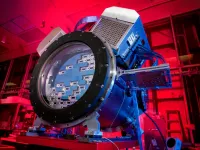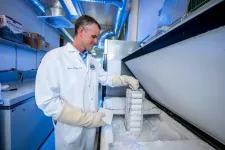(Press-News.org) International research led by Monash University and the Peter Doherty Institute for Infection and Immunity has achieved a proof of concept for a new, fast, portable saliva screening test that uses an infrared light technology to confirm infection with SARS-CoV-2.
The research is published today in Angewandte Chemie.
Professor Bayden Wood, from the Monash University School of Chemistry, Dr Phil Heraud formerly from the Monash Biomedicine Discovery Institute and collaborators Professors Dale Godfrey and Damian Purcell from the Doherty Institute, report on a new diagnostic approach, which involves the use of a portable infrared instrument to detect the SARS-CoV-2 virus in saliva.
The team identified a signature of the infectious agent in the infrared spectra of saliva from 27 out of the 29 SARS-CoV-2-infected human subjects who presented at The Royal Melbourne Hospital with COVID-19-like symptoms.
"The most significant advantages of using this infrared-based technology on saliva samples, include the speed and ease with which the test can be performed, its affordability and the reduced risk to both patients and healthcare workers," said Professor Wood.
The scientists say this is very encouraging preliminary research and are keen to see further testing with a larger patient cohort to better understand the specificity of this approach.
A portable infrared spectrometer was modified to enable high throughput screening enabling the samples to be rapidly scanned in a contactless mode without having to clean the instrument between measurements.
Professor Wood estimates that this technique could be capable of screening 5000 samples per day per instrument, with results for each sample being ready in five minutes.
Dr Heraud said because the infrared light interacted with the vibrations of molecules, it could be used to generate a spectrum that represented a unique chemical fingerprint of the sample that was then processed using machine learning algorithms.
"The approach has significant advantages over the standard Real Time Reverse Transcription Polymerase Chain Reaction (RT-PCR) that is the current gold standard for detection," said Professor Godfrey.
"As we know, this requires that samples are sent to a dedicated laboratory and results take a day or more".
According to Professor Purcell the proposed new test also avoids the discomfort associated with nasopharyngeal swabs, an advantage that could improve community participation in testing.
"A person can contribute the sample by simply dribbling into a sterile container," he said.
"The result can be derived in less than five minutes and a rapid result minimises the delay in determining if quarantine is required, therefore minimising the risk of further spread of infection."
A similar infrared technique known as Attenuated Total Reflectance (ATR) spectroscopy has previously been used by the Monash researchers to detect malaria and hepatitis.
The new transflection infrared based approach offers triple the absorbance and hence interrogates more saliva to detect pathogens compared to the traditional ATR technology.
The speed and versatility of the technique potentiates its use for point-of-care screening at airports, sporting venues, universities or schools, to triage patients for RT-PCR testing.
Although multiple techniques were used in validating the approach, Professor Bayden Wood carried out much of the initial work using the infrared microspectroscopy beamline at the Australian Synchrotron (AS), with support from the beamline team.
The measurements performed at the AS were recorded from highly purified clusters of virus, provided by the team at the Doherty Institute.
The unique infrared RNA signature from the SARS-CoV-2 virus was then detected in the infrared spectra of the saliva samples recorded using the portable instrument.
INFORMATION:
Other contributors to the research included the University of Melbourne, The Royal Melbourne Hospital, the Dublin Institute of Technology (Ireland), the University of Strathclyde (Scotland), Elettra-Sincrotone Trieste (Italy), and the Area Science Park Trieste (Italy).
DOI references for the English and German edition: 10.1002/anie.202104453 and 10.1002/ange.202104453
On scales too small for our eyes to see, the business of life happens through the making of proteins, which impart to our cells both structure and function. Cellular proteins get their marching orders from genetic instructions encoded in DNA, whose sequences are first copied and made into RNA in a multi-step process called transcription.
A research collaboration at Colorado State University specializes in high-resolution fluorescence microscopy and computational modeling to visualize and describe such stuff-of-life processes in exquisite detail, ...
SAN ANTONIO (May 27, 2021) -- One-fifth of babies who inherit a genetic variant located on chromosome 16 will develop autism spectrum disorder (ASD) by age 3. The variant is called 16p11.2 deletion.
Noboru Hiroi, PhD, of The University of Texas Health Science Center at San Antonio (also referred to as UT Health San Antonio), is studying mice that have this deletion. The team, which includes colleagues from Japan, Ireland and the U.S., is harnessing the power of machine learning to understand which vocalizations of the newborn mouse pups are most predictive of social abnormalities one month ...
Nobody likes driving in a blizzard, including autonomous vehicles. To make self-driving cars safer on snowy roads, engineers look at the problem from the car's point of view.
A major challenge for fully autonomous vehicles is navigating bad weather. Snow especially confounds crucial sensor data that helps a vehicle gauge depth, find obstacles and keep on the correct side of the yellow line, assuming it is visible. Averaging more than 200 inches of snow every winter, Michigan's Keweenaw Peninsula is the perfect place to push autonomous vehicle tech to its limits. In two papers presented at SPIE Defense + Commercial Sensing 2021, researchers from Michigan Technological University discuss solutions for snowy driving scenarios that ...
Ionizing radiation is used for treating nearly half of all cancer patients. Radiotherapy works by damaging the DNA of cancer cells, and cells sustaining so much DNA damage that they cannot sufficiently repair it will soon cease to replicate and die. It's an effective strategy overall, and radiotherapy is a common frontline cancer treatment option. Unfortunately, many cancers have subsets of cells that are able to survive initial radiotherapeutic regimens by developing mechanisms that are able to repair the DNA damage. This often results in resistance to further radiation as cancerous growth recurs. But until recently, little was known about exactly what happens in the genomes of cancer cells following radiotherapy.
To probe the traits of post-radiotherapy cancer ...
May 27, 2021 - Patients undergoing total hip arthroplasty (THA) show significant reduction in pain and other symptoms and improvement in walking gait biomechanics. However, those improvements do not lead to increased daily physical activity levels, reports a study in The Journal of Bone & Joint Surgery. The journal is published in the Lippincott portfolio in partnership with Wolters Kluwer.
The findings "present a worrying picture that while patients have the opportunity to be more physically active through improvements in functional capacity, their physical behaviors do not change," according to the new research, led by Jasvir S. Bahl of the University of South Australia, Adelaide, in collaboration with the University of Adelaide, Flinders University, ...
In 29 new scientific papers, the Dark Energy Survey examines the largest-ever maps of galaxy distribution and shapes, extending more than 7 billion light-years across the Universe. The extraordinarily precise analysis, which includes data from the survey's first three years, contributes to the most powerful test of the current best model of the Universe, the standard cosmological model. However, hints remain from earlier DES data and other experiments that matter in the Universe today is a few percent less clumpy than predicted.
New results from the Dark Energy Survey (DES) use the largest-ever sample ...
LA JOLLA, CA--Even before the COVID-19 pandemic, most people in the United States already had been sick with a coronavirus, albeit a far less dangerous one. That's because at least four coronaviruses in the same general family as SARS-CoV-2 cause the benign yet annoying illness known as the common cold.
In a new study that appears in Nature Communications, scientists from Scripps Research investigated how the immune system's previous exposure to cold-causing coronaviruses impact immune response to COVID-19. In doing so, they discovered one cross-reactive coronavirus antibody that's triggered during a COVID-19 infection.
The findings will help in the pursuit of a vaccine or antibody ...
Although it is not spread through human contact, Francisella tularensis is one of the most infectious pathogenic bacteria known to science--so virulent, in fact, that it is considered a serious potential bioterrorist threat. It is thought that humans can contract respiratory tularemia, or rabbit fever--a rare and deadly disease--by inhaling as few as 10 airborne organisms.
Northern Arizona University professor David Wagner, director of the Pathogen and Microbiome Institute's (PMI) Biodefense and Disease Ecology Center, began a three-year project in 2018 to better understand the life cycle and behavior of F. tularensis, ...
An estimated one in seven Ohio women of adult, reproductive age has visited a crisis pregnancy center, a new study has found.
In a survey of 2,529 women, almost 14% said they'd ever attended a center. The prevalence was more than twice as high among Black women and 1.6 times as high among those in the lowest socioeconomic group, found a research team from The Ohio State University. Their study appears in the journal Contraception.
Crisis pregnancy centers are often supported by religious organizations and are designed to discourage women with unintended pregnancies from choosing abortion, though they don't typically advertise themselves as anti-abortion. In Ohio, where more than 100 centers are spread throughout the state, they are funded by state dollars. In 2019, during ...
Local management of coral reefs to ease environmental stressors, such as overfishing or pollution, could increase reefs' chances of recovery after devastating coral bleaching events caused by climate change, a new study finds. The results suggest that caring for reefs on a local scale might help them persist globally. When waters warm, corals can die quickly and en masse in coral bleaching events. Marine warming due to climate change has resulted in sharp increases in both the frequency and magnitude of these mass mortality events, which have already caused severe ...



